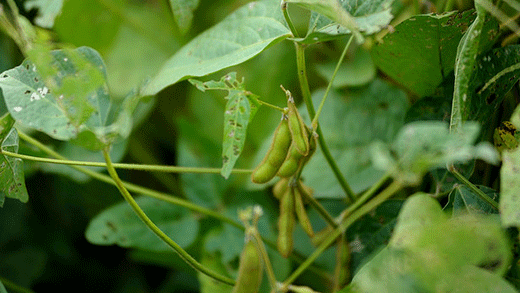
The U.S. Environmental Protection Agency extended the use of dicamba-based herbicides to July 31 after a federal court had earlier ruled that application of those products should end immediately. (File photo)
Federal agency helps ease anxiety on herbicide’s use through July
MANHATTAN, Kan. – Farmers and commercial applicators in Kansas and other states will be allowed to use dicamba-based herbicides on soybean and cotton fields through July 31, the net result of a volley of decisions made by a federal appeals court and the Environmental Protection Agency in the past week.
The issue had caused confusion – and likely concern – among the nation’s farmers, many of whom had already planted crops containing genetics that allow the use of dicamba to control weeds in their fields.
The U.S. Court of Appeals for the Ninth Circuit, based in San Francisco, ruled on June 3 that the EPA’s approval of three herbicides — XtendiMax, Engenia and FeXapan – must be vacated (or ended) immediately. In the United States, it is estimated that those products – which allow ‘over-the-top’ application — are used to control weeds on an estimated 60 million acres of soybeans and cotton.
“The timing of that announcement could hardly have been worse for farmers,” said Sarah Lancaster, a weed management specialist for K-State Research and Extension. “We’re in a time when a majority of soybeans in Kansas have been planted. With our recent rains and warm temperatures, farmers have been thinking hard about post-emergent herbicide applications, and now is the time to be doing those. We have to stay ahead of pigweeds and other weeds.”
Roger McEowen, a professor of agricultural law and taxation at the Washburn University School of Law, said the case was originally brought to the federal appeals court 15 months ago, but not heard until this spring.
“The court had this case in front of them as of January 2019 and knew that this was a time sensitive matter,” McEowen said. “They knew that farmers would be purchasing these products in a package deal – seeds and the accompanying herbicides – and they’d be paying a hefty tech fee to get all of this in either late 2019 or early 2020 for use in the 2020 growing season.”
Had the case been heard last fall, which would have been a reasonable timeframe according to McEowen, “farmers would have known where they stood before they made these decisions about what seeds they would use to plant soybeans or cotton this year.”
As a federal court, the Ninth Circuit’s decision was thought to have implications for use in 39 states. However, according to McEowen, the EPA countered with an argument that the court’s decision only made the sale and movement of that product illegal – which is relevant to manufacturers and distributors.
“But they said the court did not make the use of the product illegal under the Federal Insecticide, Fungicide and Rodenticide Act (FIFRA),” McEowen said. “That means that use of the product is not illegal when the registration is cancelled, and it’s up to the EPA to decide what to do with it at that point.”
The EPA has since ruled that farmers and commercial applicators can use herbicides currently on the farm or in inventory through July 31. The next few weeks are thought to be a crucial time to fight back weeds trying to overtake farm crops. The EPA noted that farmers can commercial applicators must continue to follow label directions for use of those products.
“Well, you take this to the end of July and the problem is over,” McEowen said. “These herbicides will not be utilized (in Kansas) probably past the Fourth of July, let alone the end of the month.”
Lancaster said another product, Tavium, is not affected by the court’s order. She said that product is a good option for producers who do not currently have the three products vacated by the court.
“The application window for Tavium is limited to the V4 (fourth trifoliolate) growth stage or before, so farmers will have to act quickly with those applications,” said Lancaster, who has written an article in the K-State Department of Agronomy’s e-Update newsletter on that topic.
She noted there are a few other non-dicamba options, namely group 14 or group 15 herbicides (also known as a protoporphyrinogen oxidase, or PPO, inhibitors).
“Any products that contain those herbicides would be good candidates to include in your post-emergent herbicide applications,” said Lancaster, cautioning, however, about those products’ potential to cause crop injury or disrupt future crop rotations.
For more information, farmers should visit with their crop consultant or their local K-State Research and Extension agent.
The weekly e-Update from K-State’s Department of Agronomy is available online.
